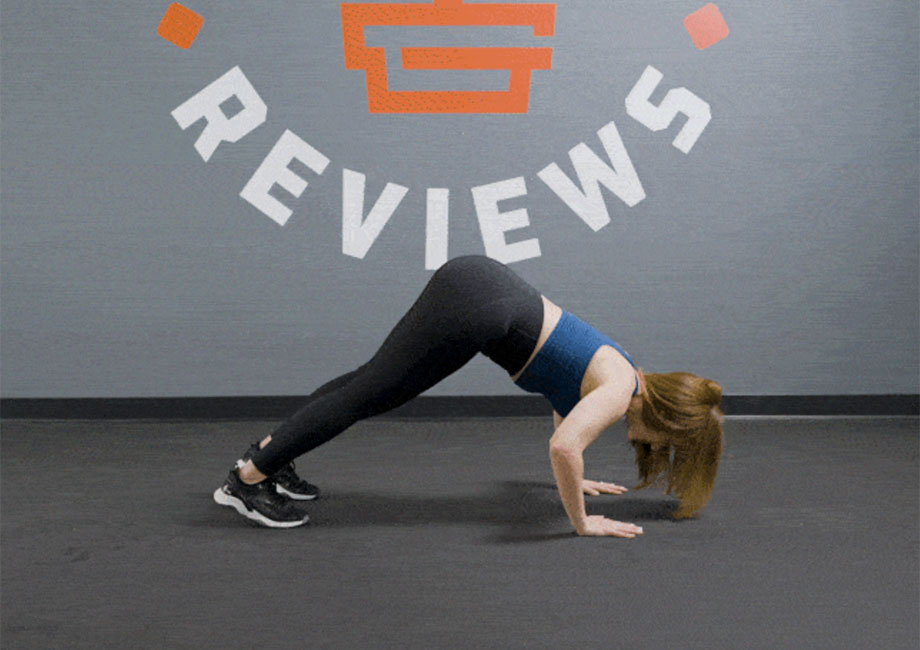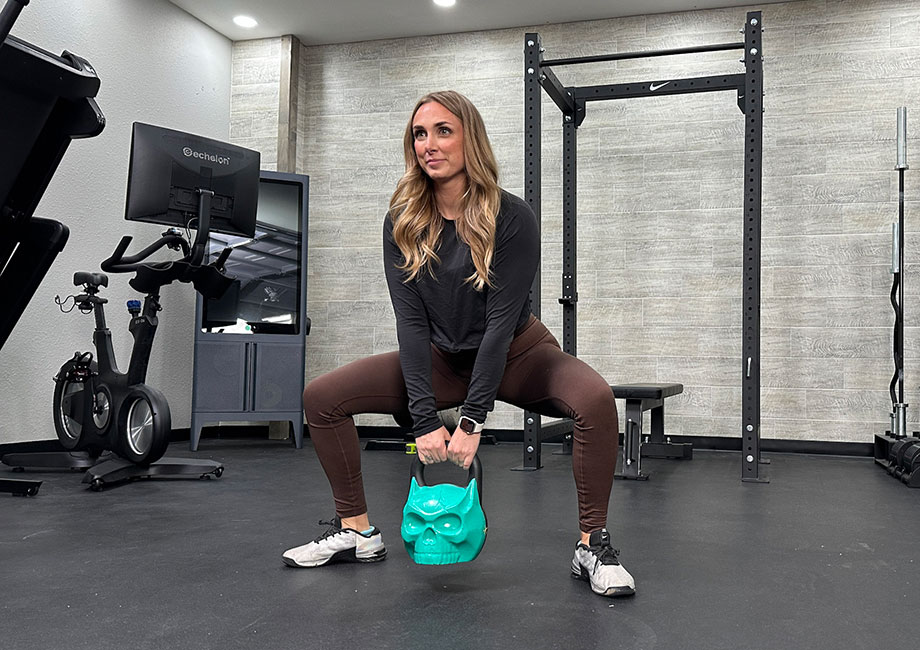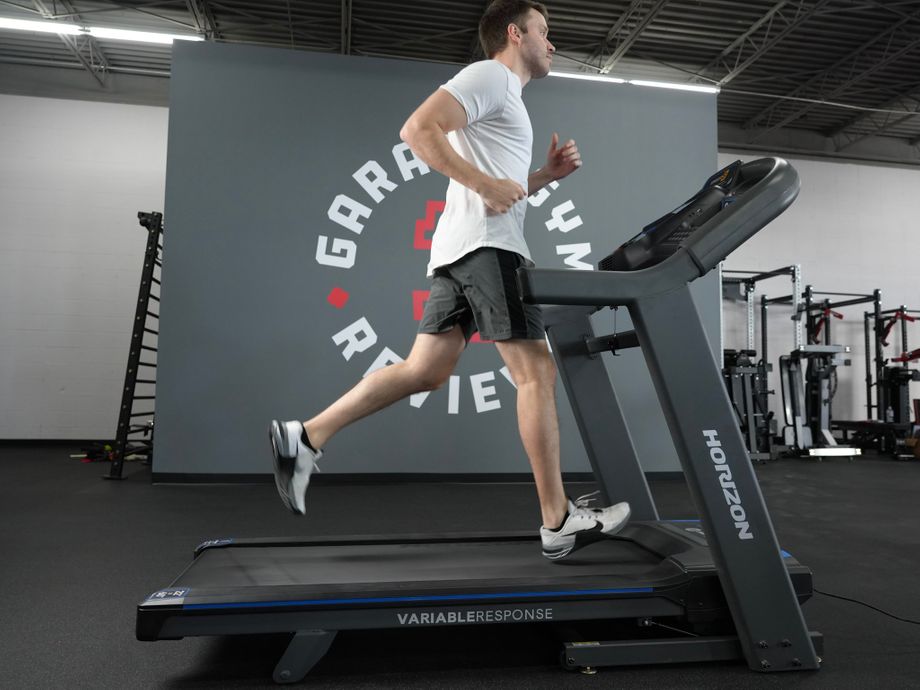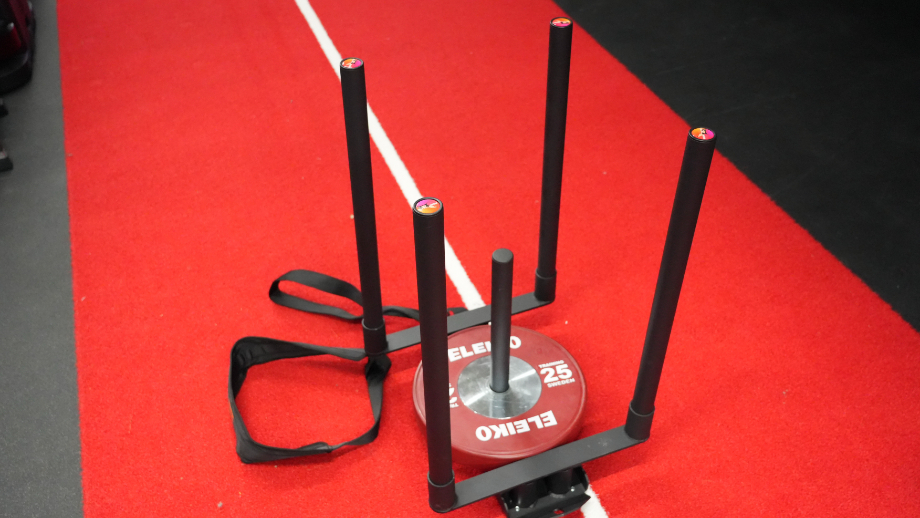Push-ups are among the best bodyweight exercises at your disposal. They provide activation throughout your whole body and help build strength, muscle, and stamina. Plus, they’re endlessly versatile. I mean, the sheer number of push-up variations at your disposal is staggering!
We’re covering one of the most underrated variations that’ll totally torch your shoulders: the pike push-up. Whether you’re looking to improve shoulder strength and stability, target your core with more intensity, or get prepped for learning how to do a handstand, this is the move.
Kate Meier, NASM-CPT, USAW-L1, CF-L1, and GGR director of content, covers how to do pike push-ups, benefits, alternatives, and more. Learn how to push your bodyweight training to the next level below!
How To Do a Pike Push-Up
Pike push-ups are effective, but they’re certainly not easy. The positioning feels awkward to many, especially those prone to dizziness, and requires a solid foundation to maintain control. So, don’t rush these if they’re new to you.
Take your time, check in with your form frequently, and, when in doubt, consider working with a certified personal trainer or other qualified fitness professional.
How to do it:
- Start from a high plank position with your hands shoulder-width apart.
- Lift your hips up and back to form an upside down V with your body.
- Bend your elbows to lower your upper body forward and down toward the floor.
- Continue until your elbows are fully bent.
- Pause, then extend your elbows to return to the starting position.
- Repeat for reps.
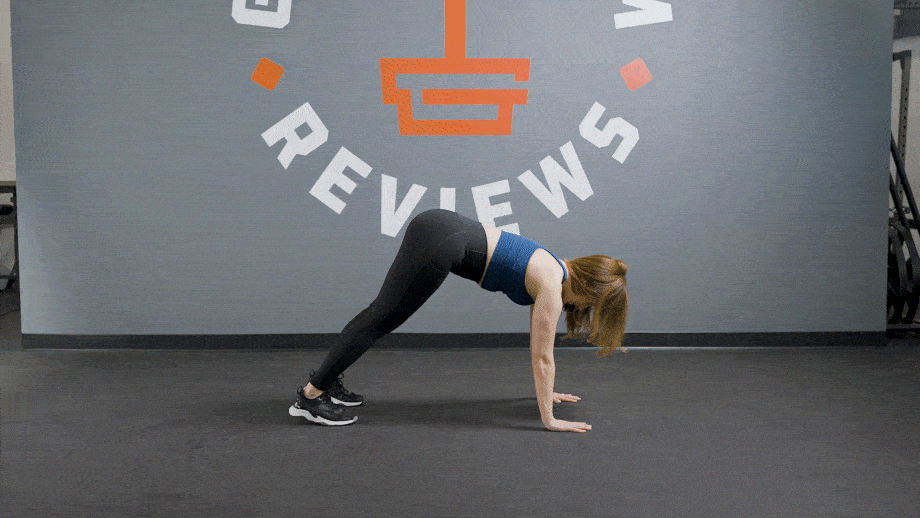
Modifications
- Dial it back: Regular push-ups should help you build general upper-body strength that’ll translate to an easier time with pike push-ups. Taking a beginner’s yoga class may help as well, as poses like downward-facing dog can strengthen your wrists and shoulders immensely.
- Make it harder: Placing your feet on a plyometric box, piece of furniture, or even a suspension trainer helps you make your positioning more vertical, which increases the challenge and activation. Progressing to handstand push-ups will also elevate your difficulty level.
How To Do Pike-Push-Ups At Home
The beautiful thing about bodyweight exercises is that you can still do them even when no equipment is available to you. All you need is some spare floor space to assume the position and complete your pike push-ups. That said, your wrist joints may be happier when using one of the best exercise mats for cushioning.
Pike Push-Up Variations
- Single-arm pike push-up: As if pike push-ups weren’t hard enough, you can up the ante by removing one arm from the equation and doing your push-ups as a single-arm exercise. They’re super difficult but great for correcting muscular imbalances.
- Deficit pike push-up: Propping your feet on a plyo box or piece of furniture increases the angle, thus increasing the activation. You can make things even more intense by placing your hands on bumper plates and creating a deficit to increase your range of motion. That’s good news because a larger range of motion, more time under tension, and more work performed per rep equals more done in less time!
- TRX pike push-up: Okay, so you really want to put your fitness to the test? Slide your feet into the handles of a TRX Suspension Trainer, get into the pike push-up position, and have at it. With your feet suspended in midair, you’re going to need to recruit your core big time to hold yourself steady and maintain proper form.
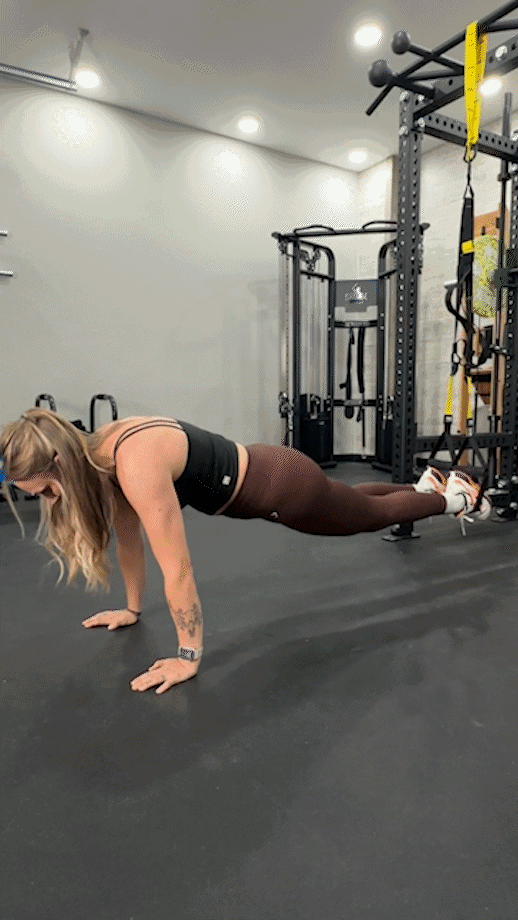
RELATED: The 10 Best TRX Exercises
Pike Push-Up Alternatives
Rome wasn’t built in a day, nor was it built with a single brick. So, the pike push-up is one hefty brick for building your fitness, but many moves at your disposal can also contribute to your cause. Here are a few of our favorite pike push-up alternatives to round out your game.
Decline Push-Up
Why do it: “The decline push-up serves as a middle step between the regular push-up and the pike push-up,” says Kate Meier, NASM-CPT, USAW-L1, CF-L1. “The movement mechanics are very similar to the standard push-up, but there’s more emphasis on the anterior deltoids and upper pecs thanks to the decline.”
How to do it:
- From the quadruped (all fours) position, place your hands on the floor directly beneath your shoulders and step your feet back onto a lifted platform, weight bench, or plyo box. Your body should form a straight line from your shoulders to feet.
- Bend your elbows, keeping them tucked into your torso, to lower your chest toward the floor.
- Lightly touch your upper chest to the floor.
- Push yourself back up by extending your elbows.
- Repeat for reps.
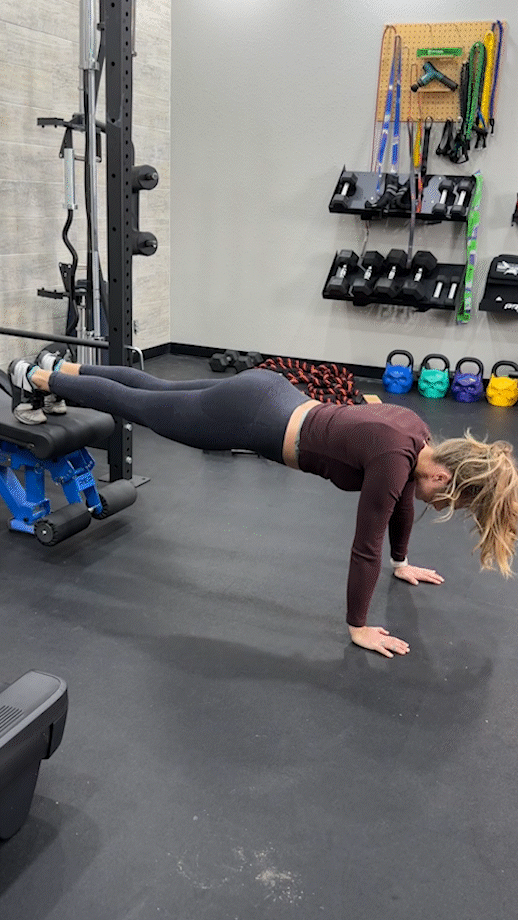
Handstand Push-Up
Why do it: The handstand push-up takes your pike-up and turns the intensity up to eleven. This variation takes coordination, focus, and a strong fitness foundation because it torches your delts, traps, upper pecs, and triceps like nobody’s business.
How to do it:
- Plant your hands on the floor shoulder-width apart, and kick your feet up and over until they rest against a wall. (You can also place a handstand push-up pad on the floor for assistance.)
- Brace your core and relax your head and neck.
- Slowly bend your elbows to lower the crown of your head toward the ground until it lightly touches the floor or pad.
- Extend your elbows to push through your hands back to the starting position.
- Repeat for reps.
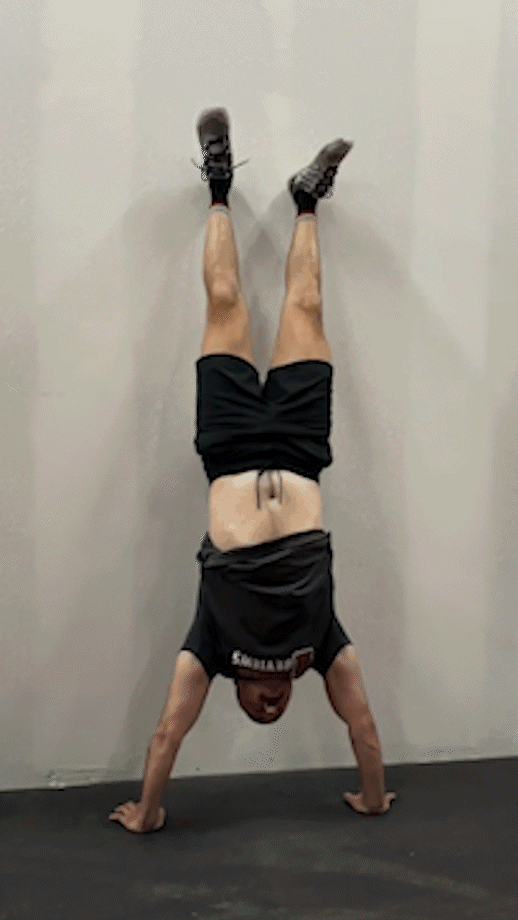
Push Press
Why do it: Are you looking for a barbell lift to supplement your bodyweight training? The push press is an excellent choice, as it recruits muscle groups like your upper back and shoulder muscles to serve as a major upper-body builder. Plus, this movement incorporates a triple extension of your ankles, knees, and hips, meaning you’ll develop explosive power, too.
How to do it:
- Set the J-hooks of your squat stand or power rack to shoulder height, rack a barbell, and load it to your desired weight. Stand in front of the bar with your feet shoulder-width apart.
- Unrack the bar onto your upper chest in the front rack position. Step away from the rack.
- Brace your core, breathe in, push your hips back, and bend your knees slightly.
- Exhale as you extend your knees and hips and press the barbell upward.
- Extend your ankles as the bar travels to the overhead lockout position.
- Squeeze your glutes, traps, and delts in the end position.
- Slowly bring the bar back down to the front rack position.
- Repeat for reps then rerack the bar.
RELATED: Best Olympic Barbells
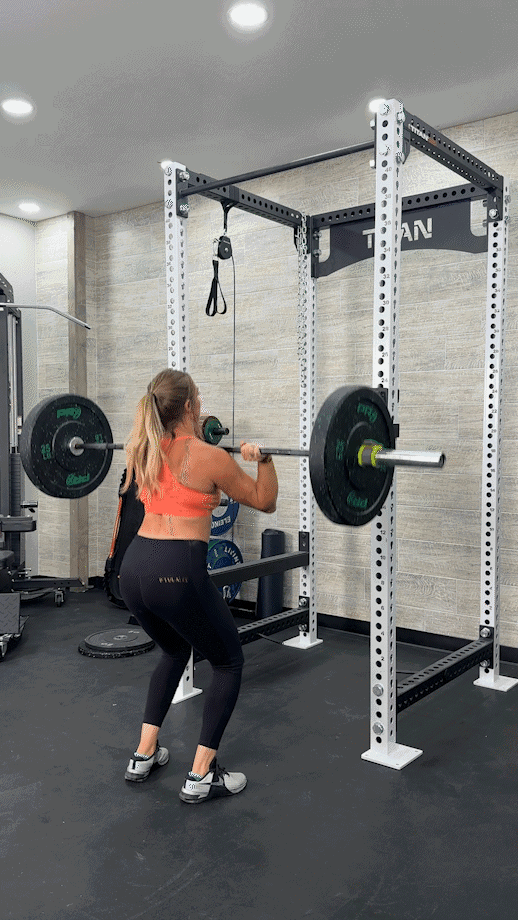
Incline Bench Press
Why do it: The International Journal of Environmental Research and Public Health1 found that performing an incline bench press shifts the emphasis of the standard bench press from chest isolation to your upper pecs and deltoids, producing more activation in your shoulders than the standard bench, which can help you master the pike push-up.
How to do it:
- Set a weight bench to between 30 and 45 degrees of incline.
- Rack your barbell and load it to your desired weight.
- Sit down, grip the bar with your hands slightly outside shoulder-width, press your upper back into the bench, press your feet into the floor, and unrack the bar.
- Stabilize the bar, then slowly lower the bar toward your chest by bending your elbows.
- Lightly touch your chest at the bottom.
- Press the bar back to the starting position by extending your elbows.
- Repeat for reps.
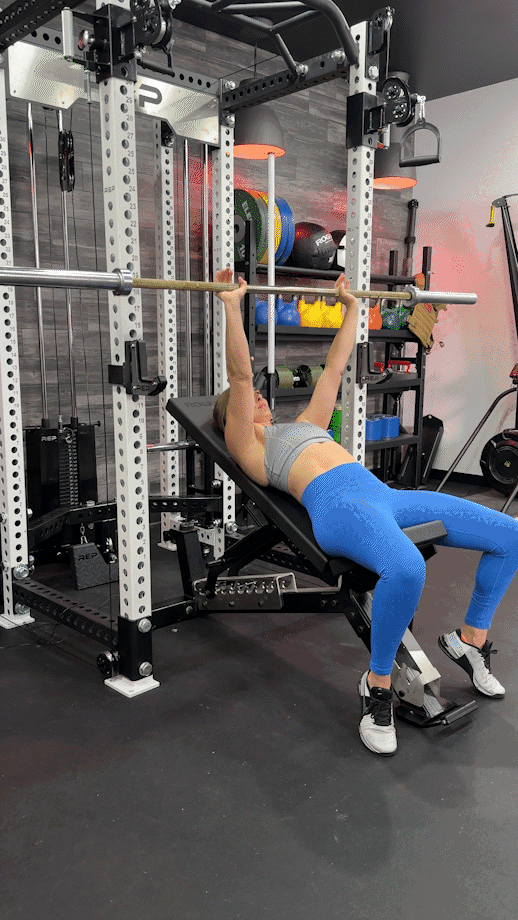
Benefits of the Pike Push-Up
The pike push-up is an unusual exercise that you may not see many people performing at the gym, so why should you? Also, what is there about this particular push-up variation that will make it worth your time?
We’re glad you asked; here are our three favorite pike push-up benefits.
Helps Improve Your Shoulder Strength and Stability
Perhaps the most pronounced benefit of the pike push-up is that it targets and strengthens your shoulder muscles, promoting greater shoulder strength and stability.
That’s important because, according to the Journal of Physical Therapy Science2, having more shoulder stability helps you correct issues with your posture, staving off aches, pains, and other maladies associated with poor posture.
More shoulder strength stability also makes completing everyday tasks and performing other fitness and weightlifting movements more manageable, so it really pays dividends to pencil in this particular push-up variation whenever you can.
RELATED: Best Shoulder Exercises
Helps Enhance Your Core Strength and Stability
“The pike push-up mostly targets upper-body muscle groups like the shoulders, chest, and triceps, but your core muscles will receive some major activation as well,” says Kate Meier, NASM-CPT, USAW-L1, CF-L1. “That’s because holding yourself in the pike position requires a strong core to stabilize the body and allow you to perform the movement with correct form.”
Core strength and stability promote good movement mechanics in life and fitness, but having a solid core is beneficial beyond that. For example, a 2022 systematic review3 in International Journal of Environmental Research and Public Health states that “core stabilization exercises can be considered a favorable method for treating pain in patients with [non-specific low back pain].” Considering the mind-blowingly large number of people on the planet suffering from low back pain, that’s a huge benefit!
RELATED: 14 Functional Core Exercises
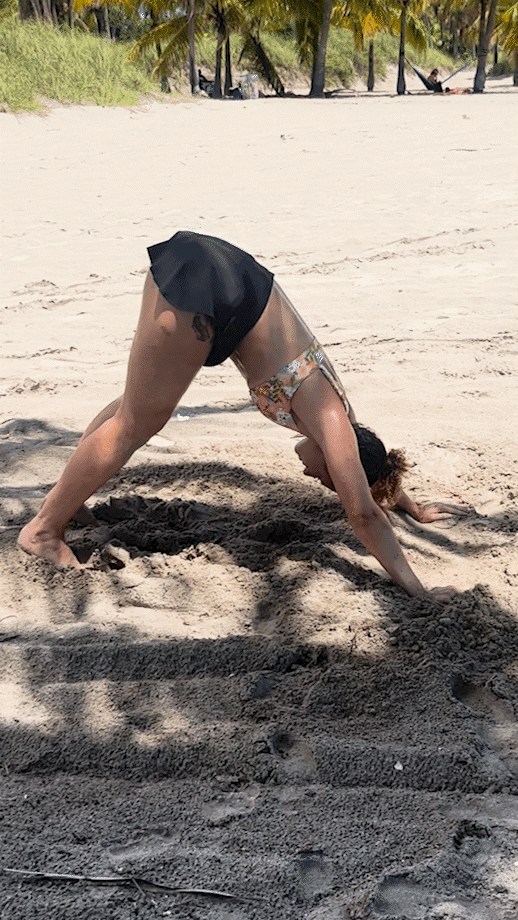
Works as a Handstand Modification
We understand that not everyone is interested in learning how to do a handstand or handstand push-ups. For the gymnasts, cheerleaders, CrossFitters, free runners, and other niche athletes, adding the pike push-up to your calisthenics workouts will help you build the muscle mass you’ll need to progress to more advanced moves down the line.
“The pike position is very similar to the handstand position, but you still have your feet firmly planted on the floor for some added stability,” says Kate, a Level-1 CrossFit coach. “So, it’s a great modification if you see handstand push-ups in your CrossFit WOD or workout plan. You’ll still build strength and stability, but it’s a more beginner-friendly version.”
Common Pike Push-Up Mistakes
We love incorporating pike push-ups in upper-body and/or full-body workouts, but it’s important to learn the correct form if you’re going to minimize your risk of injury and maximize your results.
Here are the three most common mistakes to avoid while learning and doing pike push-ups.
Flaring Out Your Elbows
“As with the regular push-up, you’ll want to keep your elbows tucked into your body while you move through the pike push-up,” says Kate. “Letting them flare out to your sides is often a sign that your triceps are being overloaded. Instead of eking out shoddy reps, you should consider scaling down to standard push-ups or modified push-ups from your knees.”
RELATED: Best Triceps Workouts
Letting your elbows flare out isn’t just poor movement mechanics. Doing this can contribute to shoulder impingement and, in the most severe cases, lead to a rotator cuff tear down the line. That’s a major ouch.
Improperly Positioning Your Head
The pike push-up can be a viable middle step between standard and handstand push-ups, but you’re by no means trying to imitate that mostly vertical movement pattern.
You want to move your head forward and down as you bend your elbows, maintaining a neutral neck and spine from start to finish. Moving only your head toward the floor, similar to the handstand push-up, often leads to elbow flaring, poor movement mechanics, and—you guessed it—an increased risk of injury.
Holding Your Breath
Forgetting to breathe is pretty common during exercise. It’s obviously very important to breathe, generally speaking, but it’s even more critical with an exercise like the pike push-up.
That’s because, since you’re nearly upside down when in the pike position, you have a greater risk of experiencing dizziness or lightheadedness, making the possibility of passing out more real. That risk is even greater if you have low blood pressure, in which case you should consult your doctor before attempting pike push-ups.
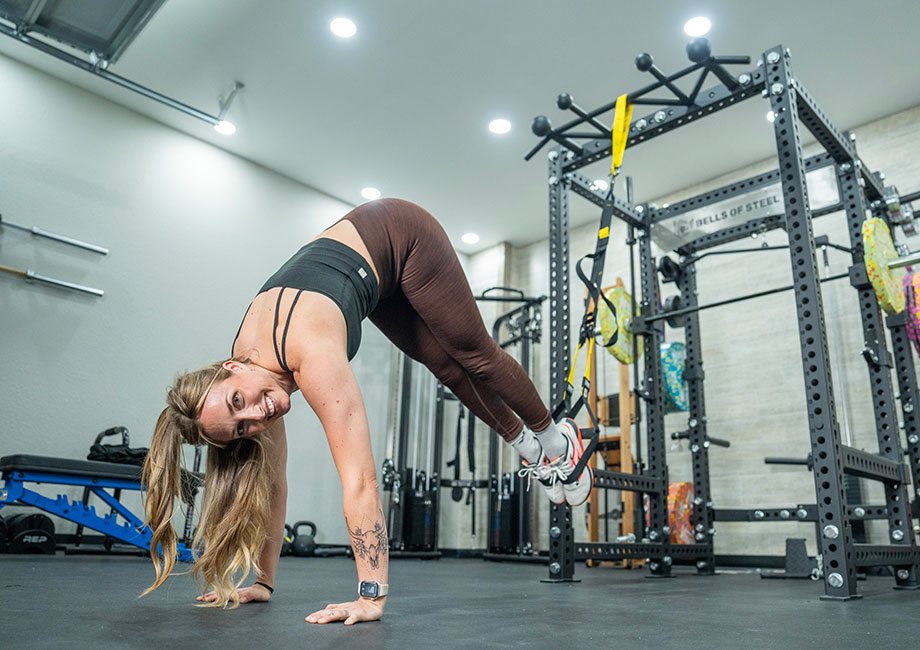
Do yourself a favor and remember to breathe. Inhale during the concentric phase, or as you’re bending your elbows to lower yourself down, then exhale as you push yourself back up during the eccentric phase of the exercise.
This technique isn’t just a handy way to remember to breathe in general, but it also helps you optimize your power output and regulate your heart rate so you can go harder for longer. That’s a triple win right there!
Muscles Worked by the Pike Push-Up
The pike push-up predominantly targets and strengthens your upper-body muscles, but you’ll still get activation throughout your full body. Some of the key muscles involved include:
- Shoulders, back, and chest: Your deltoids will get a major burn from this movement since they assist arm movements and stabilize your shoulder joint. The trapezius in your upper back and your pectoral muscles will also put in work to stabilize your shoulders.
- Triceps: The pike push-up movement requires elbow flexion and extension, which the triceps are largely responsible for. So, along with your deltoids, your triceps are primary movers.
- Core: If you’re going to stay rock-steady during the pike push-up, you’re going to need to recruit a little help from the rectus abdominis, transverse abdominis, and obliques. Your abs basically stabilize your entire body, protecting your spine and ensuring you move with good mechanics.
- Lower body: Your core doesn’t bear the full brunt of the job; lower-body muscles, like your glutes and hamstrings, also contract isometrically for some added stability.
RELATED: What Muscles Do Push-ups Work?
How To Do Pike Push-Ups: Final Thoughts
There are many effective bodyweight exercises out there, but the pike push-up is among the best and most underrated. This gem of a movement:
- Requires no equipment to perform
- Can be made more difficult with simple adjustments
- May significantly strengthen your upper body
- Provides full-body muscle activation
- Helps enhance stability in your shoulders and core
- Helps get you prepared to learn handstands
So, what are you waiting for? Pencil the pike push-up into your bodyweight training program today and see how they help you achieve your personal fitness goals!
How To Do Pike Push-Ups: FAQs
Are pike push-ups effective?
Absolutely. Pike push-ups activate muscles primarily in the upper body, namely the delts, traps, triceps, and pecs, but they also hit your core and lower body to some degree. Considering they require no equipment whatsoever, you get a lot of bang for your buck using this movement.
RELATED: At-Home Bodyweight Workout
How many pike push-ups should I be able to do?
“Should” is a problematic word in fitness because it tries to put you—the one-of-a-kind, brilliant and beautiful you—into a box with everyone else. The fact is there’s no specific number that will mean you’re “good.”
“What we like to see in our training is progression,” says Kate Meier, NASM-CPT, USAW-L1, CF-L1, and GGR director of content. “I typically recommend starting with something comfortable, even if it’s only one or two reps at a time. Do a few low-rep sets, then aim to increase the number of reps by one or two the next week. Continue in that fashion and you’ll be on the right track for some serious strength improvements.”
For more personalized fitness advice, consider working with a certified personal trainer or other qualified fitness professional.
RELATED: Reasons an Online Personal Trainer Can Be Great For Beginners
Can pike push-ups build big shoulders?
According to the Journal of Exercise Science and Fitness4, push-ups and push-up variations may be “comparably effective for muscle hypertrophy and strength gain” to a low-load bench press. Since optimal hypertrophy occurs when you’re lifting between 60% and 75% your one-rep max, you can build big shoulders using the pike push-up.
However, we recommend a multifaceted approach, including pike push-ups, other bodyweight exercises, weightlifting, and more. And, of course, never neglect your nutrition. Muscles aren’t made in the gym; they’re made in the kitchen!
What is the hardest version of push-ups?
What’s hard for you may be easy for others and vice versa. However, there are some seriously challenging push-up variations out there, namely one-handed push-ups, fingertip push-ups, and planche push-ups.
References
- Rodríguez-Ridao D, Antequera-Vique JA, Martín-Fuentes I, Muyor JM. Effect of Five Bench Inclinations on the Electromyographic Activity of the Pectoralis Major, Anterior Deltoid, and Triceps Brachii during the Bench Press Exercise. Int J Environ Res Public Health. 2020;17(19):7339. Published 2020 Oct 8. doi:10.3390/ijerph17197339
- Go SU, Lee BH. Effects of scapular stability exercise on shoulder stability and rehabilitative ultrasound images in office workers. J Phys Ther Sci. 2016;28(11):2999-3002. doi:10.1589/jpts.28.2999
- Smrcina Z, Woelfel S, Burcal C. A Systematic Review of the Effectiveness of Core Stability Exercises in Patients with Non-Specific Low Back Pain. Int J Sports Phys Ther. 2022;17(5):766-774. Published 2022 Aug 1. doi:10.26603/001c.37251
- Kikuchi N, Nakazato K. Low-load bench press and push-up induce similar muscle hypertrophy and strength gain. J Exerc Sci Fit. 2017;15(1):37-42. doi:10.1016/j.jesf.2017.06.003




